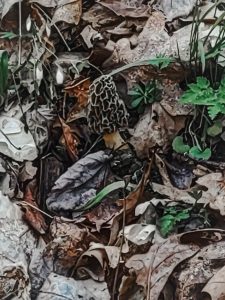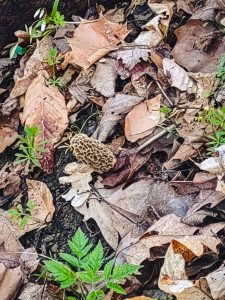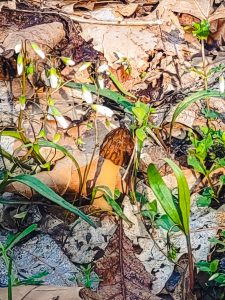Morel Mushroom Hunting 101
The FIRST RULE of Morel Hunting
Be sure you are allowed to be on the property where you are hunting.
When it’s morel hunting season, property owners are rightfully protective of their land – they enjoy hunting, too!
The SECOND RULE of Morel Hunting
Pick no False Morels – they will make you sick.
True Morels are different from False Morels in the following ways:
1) True Morel caps have a deep, honeycomb-like shape. False Morels have thin wrinkles that look like the honeycomb but are not deep.
2) True Morels are hollow inside. If you cut open a Morel and it has thin fibers and an interior body, it’s a False Morel. True Morels are hollow inside:
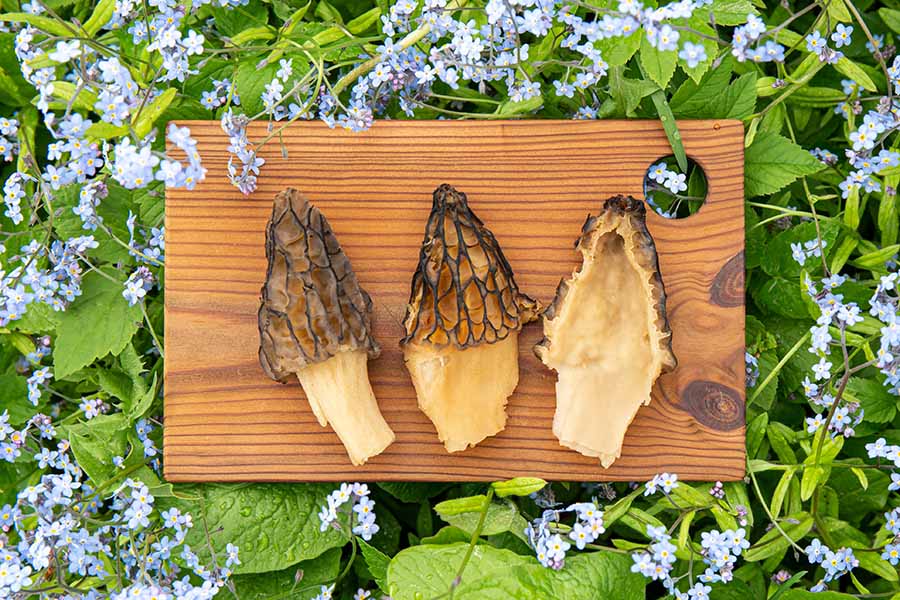
The interior of a TRUE Morel mushroom will be fully hollow and the exterior cap will have a well-defined (not wrinkly) honeycomb appearance.
False Morels grow where True Morels grow. Be careful. The False Morel contains a chemical, monomethyl hydrazine (MMH) that, if ingested, can cause dizziness, vomiting, diarrhea and in people with health issues, possible death. If you eat any mushroom and have symptoms of illness, seek medical attention immediately.
Be sure to thoroughly cook True Morels before eating to avoid indigestion and more serious impacts. Raw morels don’t taste good and need to be cooked well for health reasons.
The THIRD RULE of Morel Hunting
Bring the right tools and dress right!
You should have a sharp knife to cut the Morel away from its stem (more on that later) and a ‘breathable’ storage bag or basket where your harvest can be set without being tightly packed. Proper hunting requires proper dress and equipment. We suggest waterproof boots with good traction, jeans or thick pants to protect against briars and low-level, multi-legged hangers-on, hat to protect from sun and ticks. We also suggest: bug spray, backpack with beverages, hiking stick (an old golf club works just fine).
NOW, let’s get started!
- Morel mushroom found in Perry County, Ohio.
- Morel mushrooms enjoy hiding in plain site.
- Pro Tip: When you find ONE, keep looking in the same area – you’ll find MANY!
- Spring is Morel mushroom harvest time – April through May.
Our thanks to Perry County resident Bev Trovato who provided this gallery of Perry County Morels!
Spotting Morels
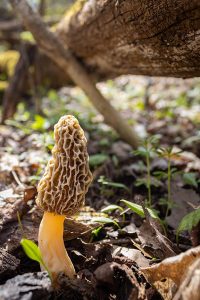
Morel mushrooms cluster near trees, particularly around dead or dying trees, and enjoy a damp environment.
The Morel mushroom comes in various shapes and sizes. All Morel caps sport a deep honeycomb pattern. They range in color from gray to yellow and show up in various shapes from oblong to bulb-like, with sizes as small as your fingertip to bigger than a cat head. These various types appear at different times. The smaller, gray versions appear early in the season; larger, yellow types pop up later in the season.
When to Hunt
Morels are best found in early spring – April through May. Weather conditions during this period have a big impact. You’ll know it’s time when temperatures start to reliably stay above 40-degrees overnight. Rainy weather – a good, wet spring – mean bigger harvests.
Where to Hunt
Early in the season, look for grassy slopes and forests that face south and west – this is where warmth will come first. As the season goes on, you can hunt virtually all slopes and forests. Dampness is helpful so check out forests that are holding moisture and feel humid. BUT, remember that too much water is not helpful – if the ground is over-soaked or swampy, it’s not ideal. Slopes where water has drained downward and creek beds that have drained out are good spots.
Morels’ Favorite Neighbors
Look along the base of Ash, Hickory, Elm and Sycamore trees. Trees that are starting to die will have bark slipping off their trunks and it’s trees in that stage of life that are particularly good Morel neighbors. Morels will grow along the roots of these trees. Abandoned or dead fruit orchards are also favored spots.
Morel Habits
Morels enjoy being in the same vicinity. If you find a strong presence around a particular tree or on a slope, continue your hunting in that area. You’re sure to find more!
How to Harvest & Store Your Morels
Cut the Morel, don’t pull it out of the ground. Leave about an inch of the stem still attached to the embedded root to promote new Morel growth! (There is some debate about whether cutting can introduce bacteria but it’s a debate.)
Place your harvested mushrooms in a well-vented basket or mesh bag. Mushrooms need to breathe. Deprived of oxygen they will start to decay and develop bacteria.
Before storing, check each mushroom for worms and insects that came along for the ride – you’ll want to remove them from your harvest so they don’t get into others. See ‘Preparing Morels for Eating’ below for removal tips!
Morels can safely be stored in your refrigerator for one week. Be sure they have space around them to breathe and are not squeezed together in the bin or in an enclosed plastic bag.
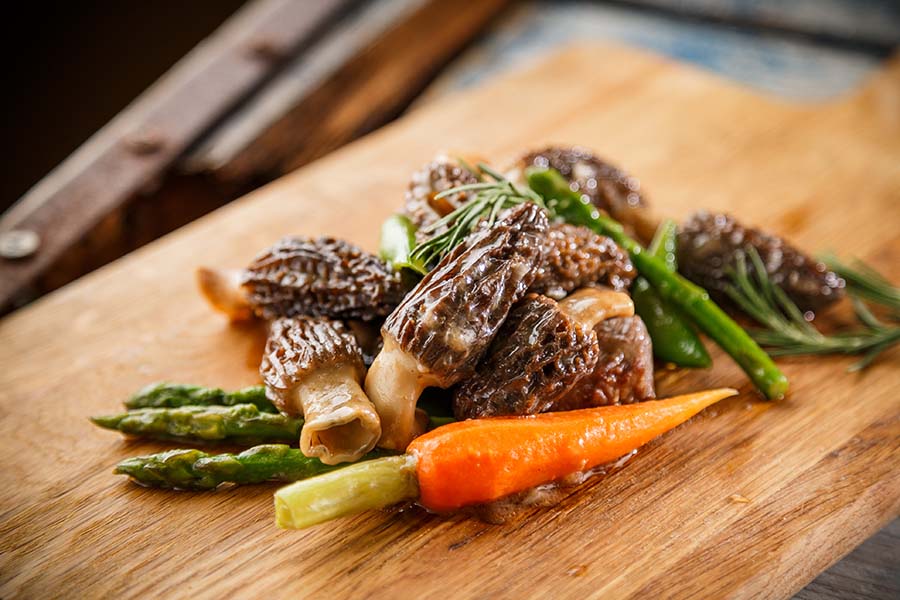
Morels can be prepared solo, sautéed with other vegetables and prepared in sauces with pasta.
How to Clean Morel Mushrooms
Morels have that beautiful honeycomb-like cap that can also be a great hiding place for dirt and small insects. They need to be briefly held in salt water and strongly rinsed before eating. Follow these steps to thoroughly clean your Morels:
1) Dissolve 2 T. salt in a gallon of water in a large bowl.
2) Add your Morels.
3) Soak the Morels for 10 minutes.
4) Use a slotted spoon to remove the Morels from the salt water and place them in a colander under the kitchen sink faucet.
5) Rinse the Morels with cold water, moving them around to be sure you’re getting into all the crevices.
6) Place fully-rinsed Morels on a paper towel to dry. Morels need to be completely dry before you move forward with cooking.
It’s Time to EAT!
IMPORTANT: Most people agree, raw Morels are not tasty and can cause tummy rumbles. It’s always best to cook your Morels.
How to Cook Morel Mushrooms
Butter-Sautéed Morels

Many people lightly dredge their cleaned Morels in flour before sautéeing in butter.
The most simple, delicious way to enjoy your harvest is to lightly flour cleaned morels and sauté them in butter. Some cooks may add garlic, tarragon and in-season ramps. Once you’ve tasted simple butter-sautéed Morels, you may decide that butter alone is the perfect pairing – Morels have a truly unique, unmistakable, savory flavor! Adjust the amount of seasoning and butter to suit the amount of Morels and your personal preferences and dietary needs.
Directions
Thoroughly clean and allow your morels to dry as described above.
Slice each Morel in half lengthwise.
Lightly dredge in flour.
Melt butter in a sauté pan.
Sauté for 3 – 5 minutes until they turn golden brown.
OPTIONS
You can add garlic powder, tarragon or other seasonings to your dredging flour. Rule of thumb is 1/2 tsp of dried seasoning per 4-6 person serving.
If using fresh garlic and herbs, wait until the last minute or two of cooking to add these to the pan so they do not turn bitter. After a minute of sautéing garlic and herbs, spoon the seasoned butter over the mushrooms to finish the dish.
Many people enjoy their Butter-Sautéed Morels in a crusty roll as a hearty Morel sandwich!

